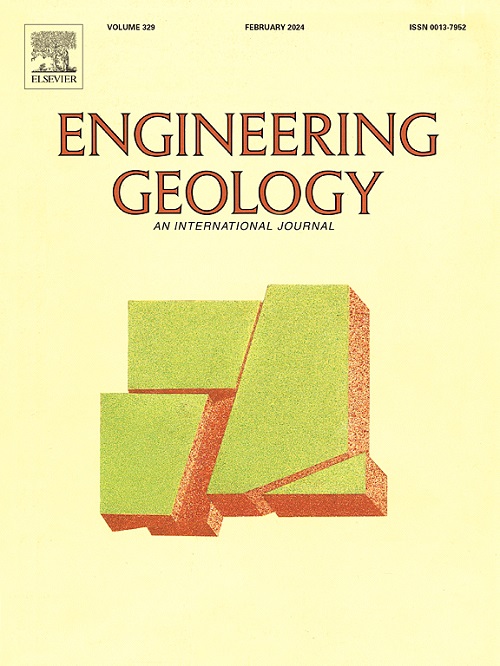Experimental investigation on swelling and gas breakthrough properties of GMZ bentonite considering alkaline solution effects
IF 6.9
1区 工程技术
Q1 ENGINEERING, GEOLOGICAL
引用次数: 0
Abstract
The degradation of concrete elements during the construction and operation of a repository can produce hyperalkaline groundwater, which may compromise the mechanical integrity and gas tightness of the engineering barrier system. Most of the previous studies focused on influences of the alkaline solutions on swelling and permeability characteristics of bentonite, but failed to address the gas migration behaviors in the bentonite specimen. In this study, a series of NaOH solutions (0.01, 0.1, 0.5 and 1 M) injection and subsequent gas injection/breakthrough experiments were carried out on the compacted bentonite specimens with 1.7 g/cm3 dry density. During the test, swelling pressure, saturated permeability, gas breakthrough pressure and effective gas permeability were recorded. After the gas injection test, the bentonite specimen was submitted for the mercury intrusion porosimeter (MIP) and scanning electron microscopy (SEM) tests to analyze microstructural and morphological changes of the specimen. Results show that, during the solution infiltration test, the axial pressure became gradually stabilized when a constant or steady-state flow condition was reached. With the increase of NaOH solution concentrations, the swelling pressure decreased while the saturated permeability increased. Before occurrence of the gas breakthrough, the effective gas permeabilities are in an order of magnitude varying between 10−24 and 10−22 m2, and show an increasing trend as NaOH solution concentrations increased. Montmorillonite minerals dissolution leads to a decrease of the strongly adsorbed water on the surface of clay minerals and a decrease of the swelling pressure. Consequently, gas can easily move in the bentonite specimen by capillary displacement or formation of the dilatant pathways at a lower injection pressure, eventually threatening the long-term safety and performance efficiency of a deep geological repository.
求助全文
约1分钟内获得全文
求助全文
来源期刊

Engineering Geology
地学-地球科学综合
CiteScore
13.70
自引率
12.20%
发文量
327
审稿时长
5.6 months
期刊介绍:
Engineering Geology, an international interdisciplinary journal, serves as a bridge between earth sciences and engineering, focusing on geological and geotechnical engineering. It welcomes studies with relevance to engineering, environmental concerns, and safety, catering to engineering geologists with backgrounds in geology or civil/mining engineering. Topics include applied geomorphology, structural geology, geophysics, geochemistry, environmental geology, hydrogeology, land use planning, natural hazards, remote sensing, soil and rock mechanics, and applied geotechnical engineering. The journal provides a platform for research at the intersection of geology and engineering disciplines.
 求助内容:
求助内容: 应助结果提醒方式:
应助结果提醒方式:


